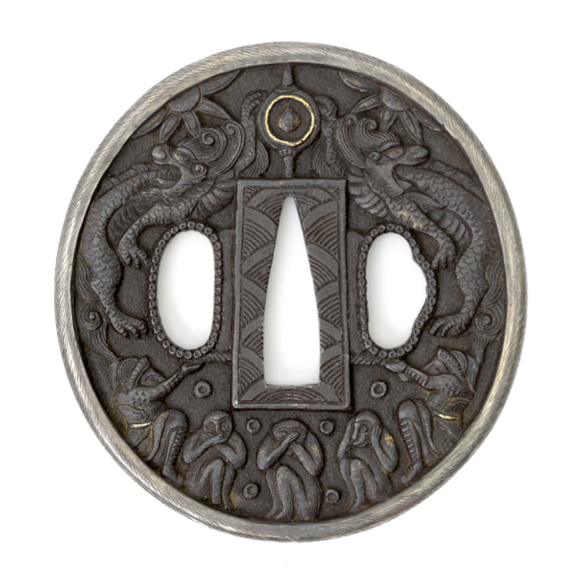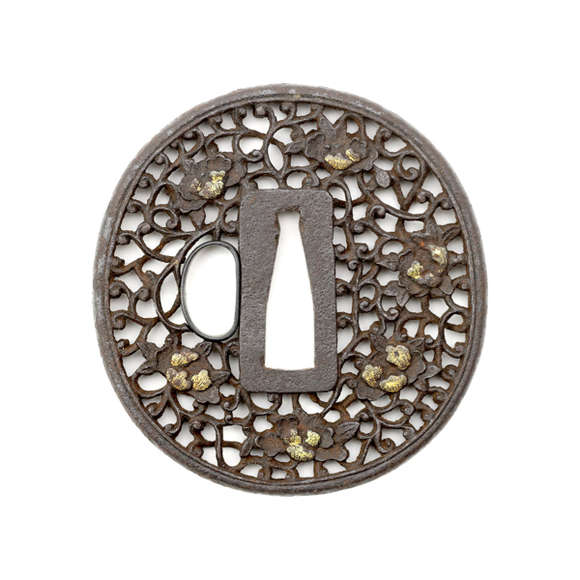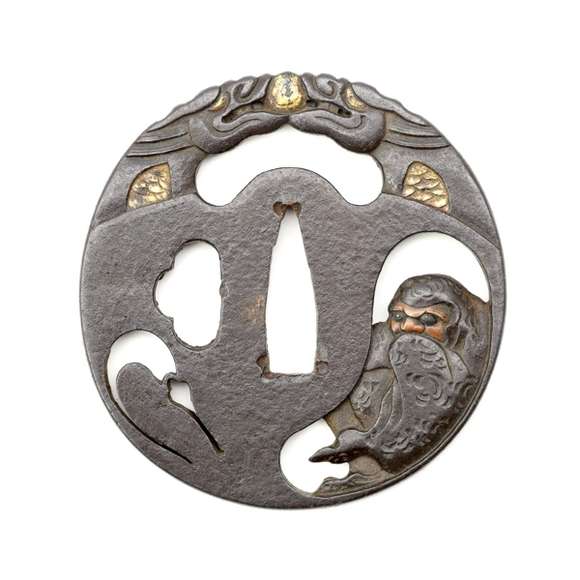Introduction
Japanese swords and fittings can come with a variety of papers that authenticate and rank the work. These papers are issued after the item is subjected to shinsha (審査), "examination", where an expert or a panel of experts judges the work and provides papers, origami.
Some papers are highly regarded and can lift a sword from the midrange to the very high-end. Others will barely be worth the paper they are written on.
The most famous issuer for these papers today is the NBTHK, and their origami is considered to carry the most weight. This article will cover the different kinds of papers they issue and have issued regarding Japanese sword blades.

Ko-Hoki Sadatsuna with NBTHK Juyō designation. Late 12th century.
Sold by Mandarin Mansion in 2022.
The NBTHK
The Nihon Bijutsu Token Hozon Kyokai (日本美術刀剣保存協会), literally translated: "The Society for Preservation of Japanese Art Swords" is the main organization for issuing certifications for Japanese swords. They also run a Japanese Sword Museum in Tokyo.
The NBTHK was originally founded in 1948 to save "art swords" from being lost in the efforts to disarm Japan following World War II. It was their job to differentiate "art swords" from simple fighting swords, the latter were discarded. From the 1950s onwards they have been issuing papers for swords.
NBTHK papers 1948-1982
They initially issued the following papers:
Kicho Ninteisho, "Precious Work".
Known as "White papers".
Issued from September 1948 - May 1982.
Tokubetsu Kicho Ninteisho, "Especially Precious Work".
Known as "Green papers".
Issued from March 1950 - May 1982.
Koshu Tokubetsu Kicho Ninteisho, "Special Extraordinary Work".
Issued September 1972 - May 1982
Juyo Token, "Very important work".
Issued from June 1958 onwards. Annually.
Tokubetsu Juyo, "Extraordinarily Important Work".
From 1972 onwards. Once every 2 years.
In 1980 it was discovered that the Japanese Yakuza had been involved in the lower level papers at local branches, where many swords were rated much higher than they were. So by 1982 the NBTHK saw a rehaul, and the local branches seized to give out papers. Especially the green papers were affected.
"Actually, green papers on a sword at this point are worse than having no papers.
They are a virtual guarantee that the sword was made by anyone else except for the guy named on the papers."
-Darcy Brockbank
Juyo Token and Tokubetsu Juyo remained unaffected, as they were always issued by the main office.
NBTHK papers 1982 - present
These papers are considered to be highly reliable, and the novice is encouraged to not spend a high amount of money on pieces without them.
Hozon (保存) "Worthy of preservation"
These are the baseline papers. Signatures on signed works are authenticated. When not signed, the shinsha team will judge the work and attribute it to a specific school.
Hozon papers are especially important when you have a piece with a big name on it. Most Japanese swords and fittings with big names are gimei, or "false signatures". Many date back to when the original maker was still active so these are genuine antiques, they are just not what they pretend to be.
On unsigned blades, they can be a good pointer for further study and possible further papers. Keep in mind that at Hozon there is limited time per piece, and when they attribute a sword to a certain smith, it's not necessarily made by that exact smith. It indicates a level within the school or tradition. When it's attributed to a low-level smith, it could be made by him or a number of smiths producing similar work within that school. If at Hozon it is attributed straight to a top smith, you have a top-level blade but the exact attribution may change at higher papers.
It is good to remember that to attain Tokubetsu Hozon requires a separate application, swords that are good enough do not automatically pass on to their highest ratable level. The fact that a blade doesn't have Tokubetsu Hozon or Juyo doesn't necessarily mean it cannot attain those levels. Every Juyo blade, at least the ones first attributed to shinsha after 1982, was once just Hozon.
For many Japanese collectors, Hozon can be enough. If you have a good quality blade signed by a top-rated smith, and with Hozon papers confirming the signature, Tokubetsu Hozon is pretty much guaranteed so why pay extra money to confirm the obvious? For unsigned blades or lower-level smiths, it makes more sense to see whether the piece could make Tokubetsu Hozon.
Tokubetsu Hozon (特別保存) "Especially worthy of preservation"
To be eligible for Tokubetsu Hozon, the piece needs to have passed Hozon or have one of the pre-1982 Tokubetsu Kicho or Koshu Tokubetsu Kicho papers. At this level, strictness is applied to flaws and workmanship. It needs to be sufficiently well made, and fewer flaws are accepted. How much a blade can get away with, depends greatly on its age and importance.
Excluded from passing Tokubetsu Hozon are:
-Re-tempered blades - unless by very famous smiths and of high value
-Edo works by lesser smiths, or of mid to lower grade workmanship
-Muromachi and Edo period unsigned blades unless unshortened, very well made, and attributable to a famous smith
-Shortened Edo period works
-Blades with hagiri, harline cracks in the tempered edge
Tokubetsu Hozon is a confirmation of the high quality of an item, and the stepping stone to higher levels. However, there is a considerable gap between Tokubetsu Hozon and Juyo and a lot of good quality pieces will always hover in-between. Good enough for Tokubetsu Hozon, not good enough for Juyo.
Juyō Token (重要刀剣) "Important Swords"
Passing Juyō is an extremely high honor, and blades with this classification are revered and sought-after.
"Over the last seven decades, the NBTHK has papered approximately two million blades. Of those, only about 10,000 are rated Juyo Token, and a mere ~1,100 are Tokubetsu Juyo Token. So swords ranked Juyo and above represent a tiny fraction of the nihonto that exist today – perhaps just 0.005%. Many collectors outside of Japan study a Juyo-level blade in hand but once in their lifetime. To experience a blade of this level in person even once is an incredible privilege."
-Darcy Brockbank, 2018
From: Locked Doors and Lethal Beauty: An Introduction to the World of Nihonto.
At Juyō, a piece must be downright important. Blades made from the Heian to Edo period may contend. The need to be of extremely high-quality workmanship and state of preservation and judged as similar to Juyō Bijutsuhin (重要美術品) "Important Work of Art", a classification granted to important pieces by the Japanese Ministry of Education up until World War 2.
The Juyō shinsha is a contest
Something to keep in mind at Juyō is that only so many pieces may pass in a single annual Juyō shinsha and so blades compete with one another. Your blade may meet the bottom Juyō requirements but if there is another blade by the same smith that is in some way better, that may pass over yours. So a sword may not be granted Juyō in one session, only to pass in another.
Caveat emptor
One needs to be careful with swords from the Juyō sessions around 20 to 28 (1974-1982), during which time they lowered the bottom bar for passing, which means blades were included that would not have been included in earlier and later sessions. If you have a Juyō sword that was awarded the papers in one of these sessions, it is not necessarily bad. But one needs to study the piece carefully to determine whether it would still pass Juyō today.
Tokubetsu Juyō Token (保存重要刀剣) "Especially Important Swords"
This is the highest rating that the NBTHK issues. Only Juyō Token compete for this highest of honors.
The swords need to be of excellent quality and in superior condition compared to the known body of Juyō works by those smiths. This means that the better the smith, the harder it is to attain. You're not just looking for the works of a grand master, you are looking for the very best works of that particular grand master.
They are equivalent in importance and value to Juyō Bunkazai (重要文化財) "Important Art Objects".
Further reading:
Nihonto rating systems by Darcy Brockbank
Tokubetsu Juyo by Darcy Brockbank
Manufacture period and Juyo Sessions by Darcy Brockbank
Green papers = no papers by Darcy Brockbank






